
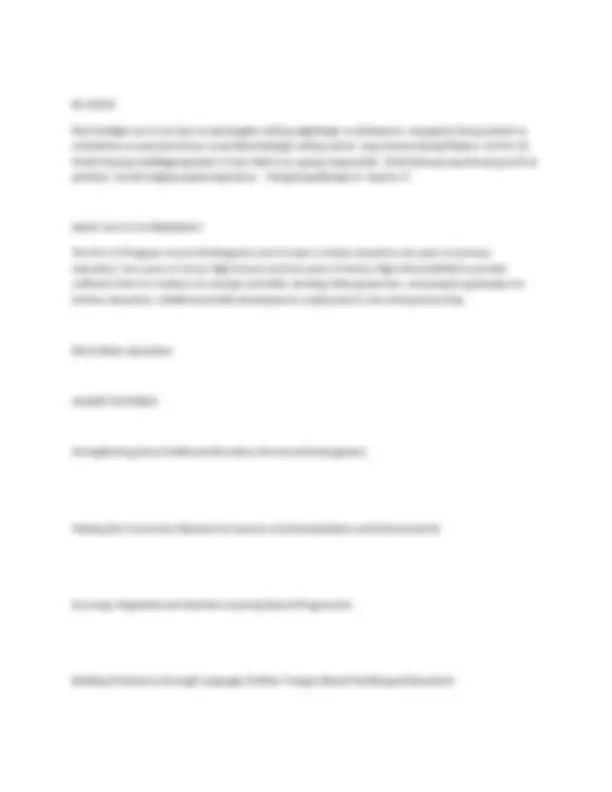
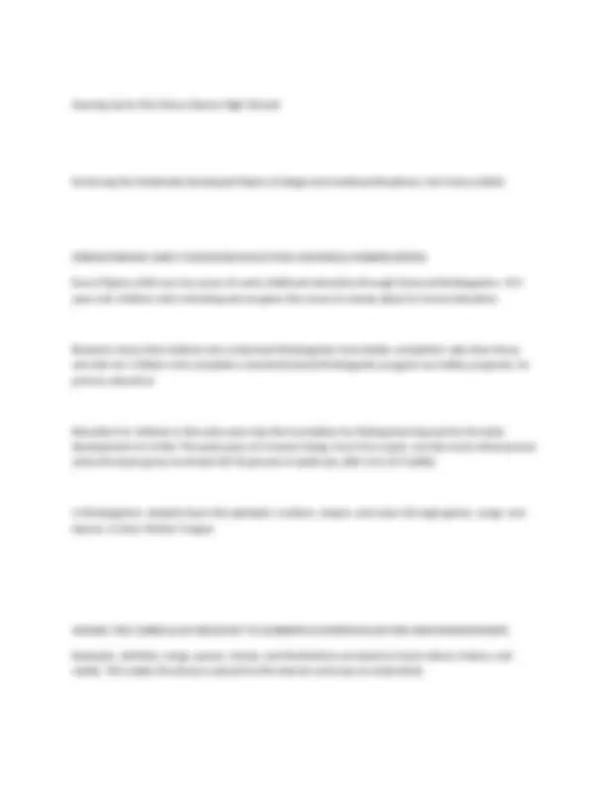
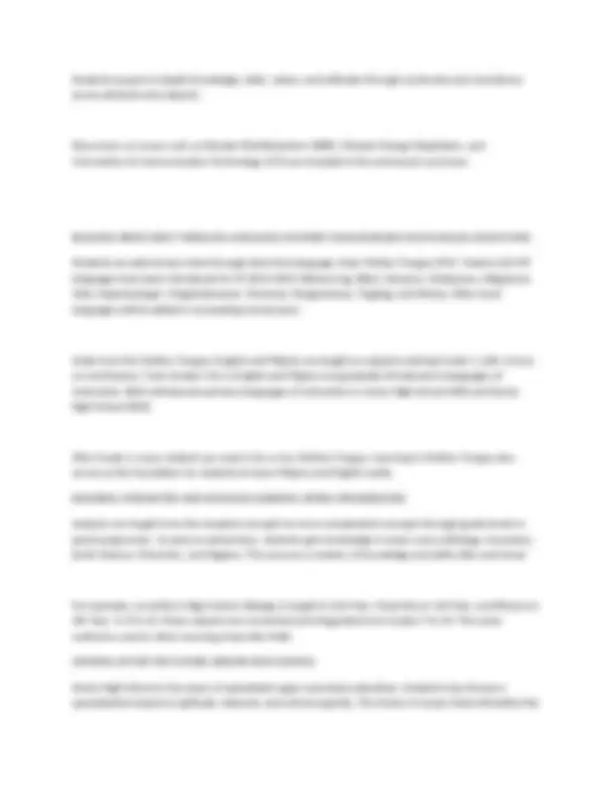
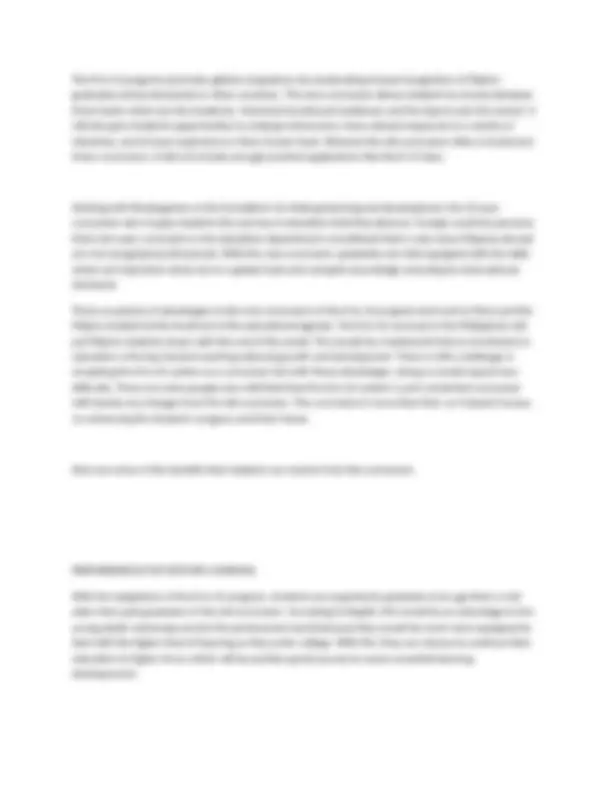
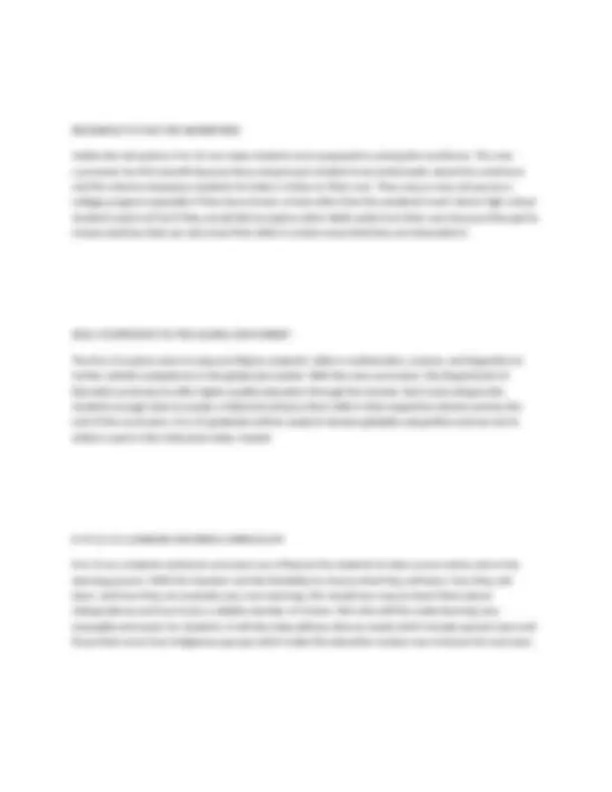
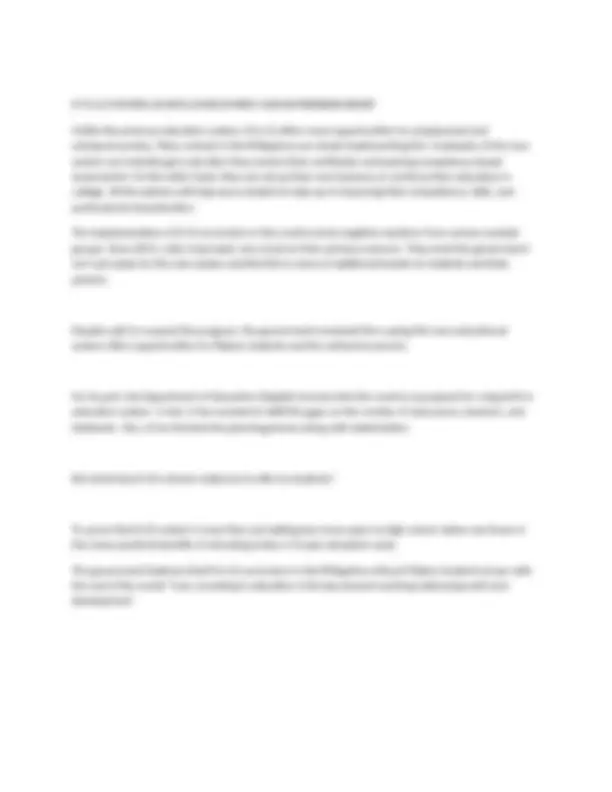


Study with the several resources on Docsity

Earn points by helping other students or get them with a premium plan


Prepare for your exams
Study with the several resources on Docsity

Earn points to download
Earn points by helping other students or get them with a premium plan
Community
Ask the community for help and clear up your study doubts
Discover the best universities in your country according to Docsity users
Free resources
Download our free guides on studying techniques, anxiety management strategies, and thesis advice from Docsity tutors
The K to 12 Program is a 13-year education cycle in the Philippines, which includes Universal Kindergarten, strengthening early childhood education, and providing sufficient time for mastery of concepts and skills. Students learn in their Mother Tongue in Kindergarten and gain foundational knowledge in various subjects. The program offers three tracks in Senior High School: Academic, Technical-Vocational-Livelihood, and Sports and Arts. Every graduate will be equipped with essential skills for further education, employment, or entrepreneurship.
What you will learn
Typology: Assignments
1 / 10

This page cannot be seen from the preview
Don't miss anything!







1.Deductive and inductive methods of teaching and learning differ in many aspects.
In Kindergarten, students learn the alphabet, numbers, shapes, and colors through games, songs, and dances, in their Mother Tongue. MAKING THE CURRICULUM RELEVANT TO LEARNERS (CONTEXTUALIZATION AND ENHANCEMENT) Examples, activities, songs, poems, stories, and illustrations are based on local culture, history, and reality. This makes the lessons relevant to the learners and easy to understand. Students acquire in-depth knowledge, skills, values, and attitudes through continuity and consistency across all levels and subjects. Discussions on issues such as Disaster Risk Reduction (DRR), Climate Change Adaptation, and Information & Communication Technology (ICT) are included in the enhanced curriculum. SHARE MENU BACK What is K to 12? FEATURES CURRICULUM GUIDE IMPLEMENTATION ACHIEVEMENTS FAQs
Gearing Up for the Future (Senior High School) Nurturing the Holistically Developed Filipino (College and Livelihood Readiness, let Century Skills) STRENGTHENING EARLY CHILDHOOD EDUCATION (UNIVERSAL KINDERGARTEN) Every Filipino child now has access to early childhood education through Universal Kindergarten. At 5 years old, children start schooling and are given the means to slowly adjust to formal education. Research shows that children who underwent Kindergarten have better completion rates than those who did not. Children who complete a standards-based Kindergarten program are better prepared, for primary education. Education for children in the early years lays the foundation for lifelong learning and for the total development of a child. The early years of a human being, from 0 to 6 years, are the most critical period when the brain grows to at least 60-70 percent of adult size..[Ref: K to 12 Toolkit] In Kindergarten, students learn the alphabet, numbers, shapes, and colors through games, songs, and dances, in their Mother Tongue. MAKING THE CURRICULUM RELEVANT TO LEARNERS (CONTEXTUALIZATION AND ENHANCEMENT) Examples, activities, songs, poems, stories, and illustrations are based on local culture, history, and reality. This makes the lessons relevant to the learners and easy to understand.
Students acquire in-depth knowledge, skills, values, and attitudes through continuity and consistency across all levels and subjects. Discussions on issues such as Disaster Risk Reduction (DRR), Climate Change Adaptation, and Information & Communication Technology (ICT) are included in the enhanced curriculum. BUILDING PROFICIENCY THROUGH LANGUAGE (MOTHER TONGUE-BASED MULTILINGUAL EDUCATION) Students are able to learn best through their first language, their Mother Tongue (MT). Twelve (12) MT languages have been introduced for SY 2012-2013: Bahasa Sug, Bikol, Cebuano, Chabacano, Hiligaynon, Iloko, Kapampangan, Maguindanaoan, Meranao, Pangasinense, Tagalog, and Waray. Other local languages will be added in succeeding school years. Aside from the Mother Tongue, English and Filipino are taught as subjects starting Grade 1, with a focus on oral fluency. From Grades 4 to 6, English and Filipino are gradually introduced as languages of instruction. Both will become primary languages of instruction in Junior High School (JHS) and Senior High School (SHS). After Grade 1, every student can read in his or her Mother Tongue. Learning in Mother Tongue also serves as the foundation for students to learn Filipino and English easily. ENSURING INTEGRATED AND SEAMLESS LEARNING (SPIRAL PROGRESSION) Subjects are taught from the simplest concepts to more complicated concepts through grade levels in spiral progression. As early as elementary, students gain knowledge in areas such as Biology, Geometry, Earth Science, Chemistry, and Algebra. This ensures a mastery of knowledge and skills after each level. For example, currently in High School, Biology is taught in 2nd Year, Chemistry in 3rd Year, and Physics in 4th Year. In K to 12, these subjects are connected and integrated from Grades 7 to 10. This same method is used in other Learning Areas like Math. GEARING UP FOR THE FUTURE (SENIOR HIGH SCHOOL) Senior High School is two years of specialized upper secondary education; students may choose a specialization based on aptitude, interests, and school capacity. The choice of career track will define the
After going through Kindergarten, the enhanced Elementary and Junior High curriculum, and a specialized Senior High program, every K to 12 graduate will be ready to go into different paths – may it be further education, employment, or entrepreneurship. Every graduate will be equipped with: Information, media and technology skills, Learning and innovation skills, Effective communication skills, and Life and career skills. Five years ago, the Philippines was the only country in Southeast Asia which provided just 10 years of basic education to its population but ever since the K to 12 implementation, the country has joined its neighbors in adopting an education system which will provide more opportunities to students on a global scale. Continued reform in the education sector is essential but with the K to 12 program, this has put the country on the right track. When people heard news of the K-12 program implementation in the country, it received mixed reactions. Suddenly, there was a combination of backlashes and praise in the background with the students left puzzled on whose voice to listen to. There are still challenges and standards of quality to consider but the important thing is to establish that development is present as a result of the new program. Now that the K to 12 system is fully implemented in the country, how did it affect the Philippine education system? K stands for kindergarten and 12 refers to the succeeding 12 years of basic education, which is why it is called K to 12. The 12 years of basic education comprises of 6 years of elementary education, 4 years of junior high school, and 2 years of senior high school. The K-12 program offers a decongested 12-year program for the students which aims to give them sufficient time to master skills and acquire basic competencies with the goal of being competitive on a global scale. Students of the new system will be equipped with the skills required to be ready for employment, entrepreneurship, middle-level skills development, and higher education even if they intend to do so after graduation.
The K to 12 program promotes global competency by accelerating mutual recognition of Filipino graduates and professionals in other countries. The new curriculum allows students to choose between three tracks which are the Academic, Technical-Vocational-Livelihood, and the Sports and Arts strand. It will also give students opportunities to undergo immersions, have relevant exposure to a variety of industries, and to have experience in their chosen track. Whereas the old curriculum offers a broad and linear curriculum, it did not include enough practical applications like the K-12 does. Starting with Kindergarten as the foundation for lifelong learning and development, the 12-year curriculum aims to give students the journey in education that they deserve. Foreign countries perceive that a ten-year curriculum in the education department is insufficient that is why many Filipinos abroad are not recognized professionals. With the new curriculum, graduates are fully equipped with the skills which can help them stand out on a global scale and compete accordingly according to international standards. There are plenty of advantages to the new curriculum of the K to 12 program and most of them put the Filipino student at the forefront of the educational agenda. The K to 12 curricula in the Philippines will put Filipino students at par with the rest of the world. This would be a testament that an investment in education is the key toward reaching national growth and development. There is still a challenge in accepting the K to 12 system as a curriculum but with these advantages, doing so would require less difficulty. There are some people who still think that the K to 12 system is just a stretched curriculum with barely any changes from the old curriculum. The curriculum is more than that, as it clearly focuses on enhancing the students’ progress and their future. Here are some of the benefits that students can receive from the curriculum: PREPAREDNESS FOR TERTIARY LEARNING With the adaptation of the K to 12 program, students are expected to graduate at an age that is a bit older than past graduates of the old curriculum. According to DepEd, this would be an advantage to the young adults venturing out into the professional world because they would be much more equipped to deal with the higher level of learning as they enter college. With this, they can choose to continue their education to higher forms which will be another great journey to access essential learning developments.
Unlike the previous education system, K to 12 offers more opportunities for employment and entrepreneurship. Many schools in the Philippines are slowly implementing this. Graduates of the new system can instantly get a job after they receive their certificates and passing competency-based assessments. On the other hand, they can set up their own business or continue their education in college. All the options will help every student to step up in improving their competence, skills, and professional characteristics. The implementation of K-12 curriculum in the country drew negative reactions from various societal groups. Since 2011, critics have been very vocal on their primary concerns. They insist the government isn’t yet ready for this new system and that this is more of additional burden to students and their parents. Despite calls to suspend the program, the government remained firm saying this new educational system offers opportunities for Filipino students and the national economy. For its part, the Department of Education (DepEd) stresses that the country is prepared for a big shift in education system. In fact, it has worked to fulfill the gaps on the number of classrooms, teachers, and textbooks. Also, it has finished the planning phases along with stakeholders. But what does K-12 scheme really has to offer to students? To prove that K-12 system is more than just adding two more years to high school, below are three of the many practical benefits of schooling under a 13-year education cycle: The government believes that K to 12 curriculum in the Philippines will put Filipino students at par with the rest of the world. Truly, investing in education is the key toward reaching national growth and development.